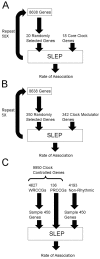A survey of genomic studies supports association of circadian clock genes with bipolar disorder spectrum illnesses and lithium response
- PMID: 22384149
- PMCID: PMC3285204
- DOI: 10.1371/journal.pone.0032091
A survey of genomic studies supports association of circadian clock genes with bipolar disorder spectrum illnesses and lithium response
Abstract
Circadian rhythm abnormalities in bipolar disorder (BD) have led to a search for genetic abnormalities in circadian "clock genes" associated with BD. However, no significant clock gene findings have emerged from genome-wide association studies (GWAS). At least three factors could account for this discrepancy: complex traits are polygenic, the organization of the clock is more complex than previously recognized, and/or genetic risk for BD may be shared across multiple illnesses. To investigate these issues, we considered the clock gene network at three levels: essential "core" clock genes, upstream circadian clock modulators, and downstream clock controlled genes. Using relaxed thresholds for GWAS statistical significance, we determined the rates of clock vs. control genetic associations with BD, and four additional illnesses that share clinical features and/or genetic risk with BD (major depression, schizophrenia, attention deficit/hyperactivity). Then we compared the results to a set of lithium-responsive genes. Associations with BD-spectrum illnesses and lithium-responsiveness were both enriched among core clock genes but not among upstream clock modulators. Associations with BD-spectrum illnesses and lithium-responsiveness were also enriched among pervasively rhythmic clock-controlled genes but not among genes that were less pervasively rhythmic or non-rhythmic. Our analysis reveals previously unrecognized associations between clock genes and BD-spectrum illnesses, partly reconciling previously discordant results from past GWAS and candidate gene studies.
Conflict of interest statement
Figures



References
-
- McGuffin P, Rijsdijk F, Andrew M, Sham P, Katz R, et al. The heritability of bipolar affective disorder and the genetic relationship to unipolar depression. Arch Gen Psychiatry. 2003;60:497–502. - PubMed
-
- McQuillin A, Rizig M, Gurling HM. A microarray gene expression study of the molecular pharmacology of lithium carbonate on mouse brain mRNA to understand the neurobiology of mood stabilization and treatment of bipolar affective disorder. Pharmacogenet Genomics. 2007;17:605–617. - PubMed

